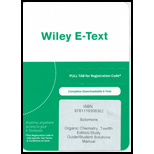
Concept explainers
Interpretation:
The two isomers of cyclopentane ring are to be drawn. The same isomers are to be labelled with the use of wedge-dashed-wedge method that depicts the
Concept introduction:
Infrared spectroscopy is a simple, instrumental technique, which determines the presence of various functional groups.
It depends on the interactions of atoms or molecules with the
In cis-isomers, substituents are on the same side of the ring skeleton.
In trans-isomers, substituents are on the opposite side of the ring skeleton.
Intramolecular hydrogen bonding shifts the
The intramolecular hydrogen-bonded band does not change its position significantly even at high dilution because the internal bonding is not altered by a change in concentration.
Want to see the full answer?
Check out a sample textbook solution
Chapter 2 Solutions
ORGANIC CHEMISTRY-ETEXT REG ACCESS
- Write a conformational structure for 1,2,3-trimethylcyclohexane in which all the methyl groups are axial and then show its more stable conformation.arrow_forwardFrom studies of the dipole moment of 1,2-dichloroethane in the gas phase at room temperature (25°C), it is estimated that the ratio of molecules in the anti conformation to gauche conformation is 7.6 to 1. Calculate the difference in Gibbs free energy between these two conformations.arrow_forwardCompounds X and Y are stereoisomers having the formula C6H12.Both X and Y react with one molar equivalent of hydrogen in the presence of a palladium catalyst to form hexane, and they each react with HBr to give a single bromoalkane product.Draw structural formulas for both X and Y.arrow_forward
- Which of the following is an incorrect statement: Isomers have the same molecular formula such as cyclohexane and 1-hexene. Conformational isomers are enantiomers or diastereomers, which can interconvert through rotations around bonds within molecules, which include anti and gauche butane. Stereoisomers have the same connectivity but different arrangement of their parts in space, which include enantiomers, diastereomer, and conformational isomers, which include cis and trans dichlorocyclobutane. O Structural or constitutional isomers are molecules of the same formula but different connectivity such as 1,1-dichlorocyclopropane and 1.2-dichlorocyclobutane.arrow_forwardWhy is a substituted cyclohexane ring more stable with a larger group in the equatorial position?arrow_forwardThe skeletal line formula for a branched alkene is shown below. (i) What is the molecular formula of this compound? (ii) How many carbon atoms are in the longest chain, ignoring the double bond? (iii) What is the longest chain incorporating both carbons of the double bond? (iv) How many substituents are on this chain? (v) Give the IUPAC name for this compound. [6]arrow_forward
- Write structures for the cis and trans isomers of (a) 1,2-dichlorocyclopentane and (b) 1,3- dibromocyclobutane. (c) Are cis-trans isomers possible for 1,1-dibromocyclobutane?arrow_forwardWhen cyclopropane is treated with HI, 1-idopropane is formed. A similar type of reaction does not occur with cyclopentene or Cyclohexane. Suggest an explanation for cyclopropane’s reactivity.arrow_forwardBased on naming branched alkyl substituents, and draw all possible alkyl groups having the formula C5H11–. Give the IUPAC names for the eight compounds of molecular formula C10H20that contain a cyclopentane ring with each of these alkyl groups as a substituent.arrow_forward
- 1,2,3,4,5,6-Hexachlorocyclohexane shows cis,trans isomerism. At one time, a crude mixture of these isomers was sold as an insecticide. The insecticidal properties of the mixture arise from one isomer, known as lindane, which is cis-1,2,4,5-trans- 3,6-hexachlorocyclohexane. Q.) Which of the alternative chair conformations of lindane is more stable? Explain.arrow_forward1,2,3,4,5,6-Hexachlorocyclohexane shows cis,trans isomerism. At one time, a crude mixture of these isomers was sold as an insecticide. The insecticidal properties of the mixture arise from one isomer, known as lindane, which is cis-1,2,4,5-trans- 3,6-hexachlorocyclohexane. Q.) Using a planar hexagon representation for the cyclohexane ring, draw a structural formula for lindane.arrow_forward1,2,3,4,5,6-Hexachlorocyclohexane shows cis,trans isomerism. At one time, a crude mixture of these isomers was sold as an insecticide. The insecticidal properties of the mixture arise from one isomer, known as lindane, which is cis-1,2,4,5-trans- 3,6-hexachlorocyclohexane. Q.) Draw a structural formula for 1,2,3,4,5,6-hexachlorocyclohexane disregarding, for the moment, the existence of cis,trans isomerism. What is the molecular formula of this compound?arrow_forward
 Introduction to General, Organic and BiochemistryChemistryISBN:9781285869759Author:Frederick A. Bettelheim, William H. Brown, Mary K. Campbell, Shawn O. Farrell, Omar TorresPublisher:Cengage Learning
Introduction to General, Organic and BiochemistryChemistryISBN:9781285869759Author:Frederick A. Bettelheim, William H. Brown, Mary K. Campbell, Shawn O. Farrell, Omar TorresPublisher:Cengage Learning Chemistry & Chemical ReactivityChemistryISBN:9781337399074Author:John C. Kotz, Paul M. Treichel, John Townsend, David TreichelPublisher:Cengage Learning
Chemistry & Chemical ReactivityChemistryISBN:9781337399074Author:John C. Kotz, Paul M. Treichel, John Townsend, David TreichelPublisher:Cengage Learning Chemistry & Chemical ReactivityChemistryISBN:9781133949640Author:John C. Kotz, Paul M. Treichel, John Townsend, David TreichelPublisher:Cengage Learning
Chemistry & Chemical ReactivityChemistryISBN:9781133949640Author:John C. Kotz, Paul M. Treichel, John Townsend, David TreichelPublisher:Cengage Learning Organic ChemistryChemistryISBN:9781305580350Author:William H. Brown, Brent L. Iverson, Eric Anslyn, Christopher S. FootePublisher:Cengage Learning
Organic ChemistryChemistryISBN:9781305580350Author:William H. Brown, Brent L. Iverson, Eric Anslyn, Christopher S. FootePublisher:Cengage Learning Chemistry: The Molecular ScienceChemistryISBN:9781285199047Author:John W. Moore, Conrad L. StanitskiPublisher:Cengage Learning
Chemistry: The Molecular ScienceChemistryISBN:9781285199047Author:John W. Moore, Conrad L. StanitskiPublisher:Cengage Learning




